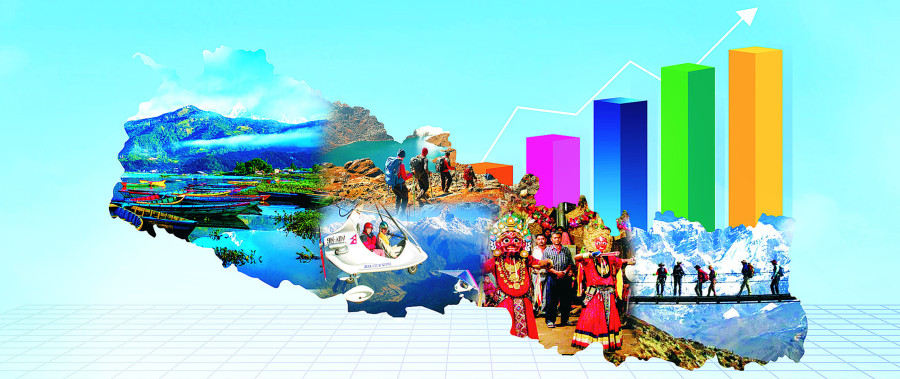Money
Tourism is Nepal’s fourth largest industry by employment, analytical study shows
The tourism sector employs 371,140 people, representing 11.5 percent of persons engaged in all industries in Nepal.
Sangam Prasain
Tourism is Nepal's fourth largest industry by employment, according to a new study.
The analytical study on tourism released by the Central Bureau of Statistics recently shows that Nepal’s tourism industry provides 371,140 jobs. This represents 11.5 percent of persons engaged in all industries in the country.
The largest industry by employment is wholesale and retail trade which accounts for 30.6 percent of the total employment in the country, followed by education with 15.9 percent and manufacturing with 15.8 percent.
According to the report, Bagmati Province, which includes Kathmandu Valley, accounts for the largest number of tourism personnel in the country, 161,674 persons or 43.6 percent.
Province 1 comes second with an employment number of 56,782 persons or 15.3 percent. Lumbini and Gandaki provinces employ 47,827 and 47,447 persons, respectively.
Sudurpaschim Province has 17,195 tourism workers, Karnali has 14,123 tourism workers and Province 2 has 26,092 tourism workers.
According to the report, the number of people engaged in restaurants and mobile food service activities is 243,790 or 65.7 percent, followed by short-term accommodation activities or the hotel industry with 76,010 people or 20.5 percent.
The country's airlines employ 2,750 people, and 17,899 people are engaged in beverage selling activities. Travel agencies provide 13,223 jobs.
The number of establishments in the tourism industry is 134,832, making up 14.6 percent of all establishments in Nepal.
Bagmati Province has the largest number of 49,234 tourism establishments, accounting for 36.5 percent of all establishments in the tourism industry. The major tourist attractions of the province are the cultural heritage of Kathmandu Valley and Chitwan National Park.
Province 1 has 24,900 tourism establishments with Everest National Park and Ilam being the main draws for visitors. The number of establishment in Gandaki Province is 16,412 with Pokhara Valley, Mt Machhapuchchhre, Annapurna range and Gorkha being the major attracting factors for tourists.
Lumbini Province has 19,211 tourism establishments and its key allures are Lumbini and Banke and Bardia national parks. Rara and Shey Phoksundo national parks are the major sites of Karnali Province which has 6,351 tourism establishments.
Sudurpaschim Province has 7,604 establishments with Khaptad National Park and Shukla Phanta National Park being its key destinations. There are 11,120 tourism establishments in Province 2 where Parsa Wildlife Reserve and Janakpur are the major tourism sites.
Nepal’s hospitality industry grew rapidly in the last decade with an increased number of arrivals.
The report said that the number of tourist standard hotels rose by 54.3 percent between 2012-13 and 2019-20 while the number of star hotels increased by 29 percent during the same period.
The number of beds in tourist standard hotels and star hotels rose by 40.9 and 38.2 percent respectively during the review period. In total, the number of beds increased by 39 percent from 31,657 in 2012-13 to 43,999 in 2019-20.
The tourism industry's contribution to the national economy and employment has been swelling. Its contribution to the national gross domestic product (GDP) and employment stood at 6.7 percent and 6.9 percent in 2019, the report said.
However, Nepal's tourism industry has not necessarily achieved its full growth potential, the report said.
Due to a surge in tourist arrivals, the amount of foreign exchange earnings from tourism also jumped from Rs11.71 billion in 2000-01 to Rs75.80 billion in 2017-18. Tourism revenue in 2017-18 was equivalent to 9.9 percent of the total foreign exchange earnings that year.
The number of international tourists in Nepal has been increasing over the years. Arrivals more than doubled from 464,000 in 2000 to 1.17 million in 2018.
According to the study, 60.7 percent of tourism establishments had male managers while 39.2 percent of them had female managers. The number of establishments with female managers in the tourism industry is the highest among all establishments in Nepal.
“Among all provinces, Province 2 has the lowest proportion of female managers (19.3 percent) while Province 1 has the highest (50.1 percent),” the report said. Accommodation and food service businesses have a higher proportion of female managers.
The report said that only 38.2 percent of the establishments in the tourism industry were registered.
The proportion of registered establishments is low in food and beverages service activities since these micro scale businesses are operating without registration knowingly or unknowingly, although laws require any business to be registered.




 12.12°C Kathmandu
12.12°C Kathmandu













%20(1).jpg&w=300&height=200)
